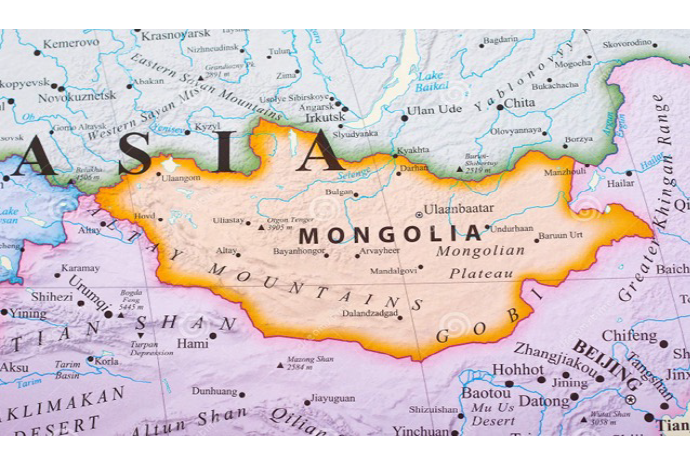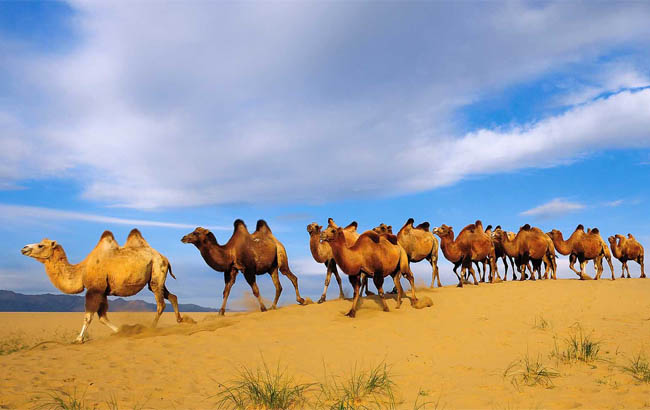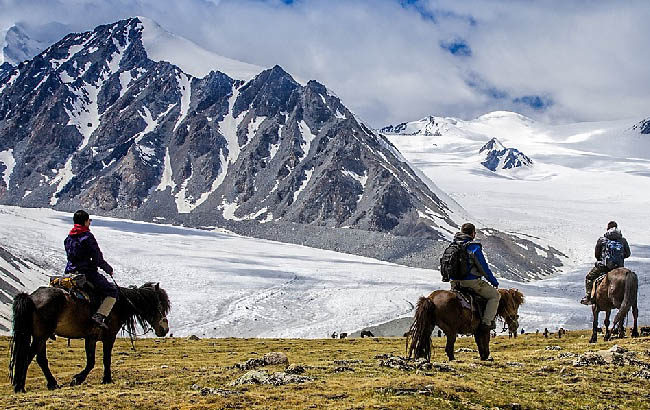Gandan Monastery
Ulaanbaatar
Gandan is the largest and most significant monastery in Mongolia and indeed, the most important to visit when you’re visiting Ulaanbaatar.
The fifth Javzandamba, who was the highest lama in the hierarchy of the Mongolian clergy, created this monastery in 1809 under the name of Shar sum (“the yellow monastery”). It was located in the centre of Ulan-Bator. In 1838, it was moved at his current location on Dalkha Hill, and took its current name.
The statue was dismantled by the Soviets in 1938 but was brought back to life in 1996 thanks to donations from locals across the city, putting into perspective just how beloved and sacred this temple is to the people of Mongolia.
The Migjid Janraisig Temple is an important part of the Gandan Monastery. The temple houses the majestic new gilded statue of Migjid Janraisig, decorated with jewels. This 26.5-meter /87feet/ high 20-ton statue is a copy of another statue that was destroyed in the 1920s by communists.
NATURAL HISTORY MUSEUM
The Natural History Museum was created in 1924 and was called “National Museum”. In 1956 it was renamed the State Central Museum and in 1997 it became the Museum of Natural History.
Today there are departments of Geography, Geology, Flora and Fauna, and Paleontology in the museum. Displays of stuffed and embalmed animals including the rare Gobi bear and wild camel, birds, and fish will give you a good idea about the rich fauna of Mongolia.
Most impressive is the Paleontology section. There are petrified eggs and bones of many dinosaurs that lived in the Gobi desert 60-70 million years ago and two complete skeletons of the flesh-eating giant Tarbosaurus and the duck-billed Saurolophus.
CHOIJIN LAMA MONASTERY
The Choijin Lama Monastery is composed of four temples that were built in the years 1904 to 1908. This was the home of Luvsan Haidav Choijin Lama, brother of Bogd Khaan and a prominent lama. Choijin Lama Museum is composed of four temples and four arch doors. It houses collections of sacred and liturgical objects, notably masks of ceremony for the tsam dance (religious dance). You will also admire paintings, sculptures, embroideries and masks dating back from 17th, 18th, 19th and 20th centuries.
Today, the Choijin Lama Temple is comprised of the Jambai Gate, the Mahrahar Temple, the Gate of Khuderati, the main temple, the Zanhang Temple, the Zuu Temple, the Yadam Temple, the mosque, and the temple.
ZAISAN HILL
The Zaisan memorial lies in the foothills to the south of Ulaanbaatar. Zaisan is a popular tourist attraction and one of the highlights of Ulan Bator due to the fantastic views it offers over the city. It was built by the Russians as a monument to Soviet soldiers fallen in World War Two.
Now the hill is also home to a sprawling modern complex with plenty of amenities for tourists and residents alike.
The outer skin and the statue are made from high quality Russian concrete, at the base of the hill there is a very large statue of Buddha popular with worshippers and visitors to the country. Buddha Park features a 23 meter tall statue of Buddha. It is worth to check out the tank exhibit at the foot of the hill.
SUKHBAATAR SQUARE
TSükhbaatar Square is the central square of Mongolia's capital Ulaanbaatar. In July 1921 in the centre of Ulaanbaatar, the ‘hero of the revolution’, Damdin Sükhbaatar, declared Mongolia’s final independence from the Chinese. The square now features a bronze statue of Sükhbaatar astride his horse. In 2013 the city authorities changed the name from Sükhbaatar Square to Chinggis Khaan Square, although many citizens still refer to it by the old name.
A large statue of Sukhbaatar, the famous patriot characterizes the square, and the square is named after this historic figure. Such important buildings as the Parliament House, Stock Exchange, the Drama Theater and Cultural Palace are located surrounding the square.
Sukhbaatar square was formed in the early part of the XIX century by the name of the Great Universe. The northern edge of the Great Pleasure was the Yellow Castle (south of the existing Child Center Center), the southern edge of the Choijin Lama Temple, the left and right sides of the monastery, and the lords.
UMEN-EKH ENSEMBLE
Tumen Ekh Ensemble of Traditional Cultural Heritage is one of the leading national song and dance ensembles in Mongolia. “Tumen Ekh” in Mongolian carries a meaning of “a leader or vanguard of all”. In 1989 a group of outstanding artists and forerunners of the field chose a tittle of a famous folk song “Tumen Ekh” and established this ensemble.
Mongolians created music through the ages using metal, stone, bamboo, leather, cattle hair and wood. Traditional Mongolian musical instruments vary from string, wind and percussion and all vividly demonstrate unique elements of nomadic culture. The most popular musical instrument is Morin khuur (horse head fiddle), which was created to replicate horse related sounds.
Guests of our country can experience the beauty of our nature, different terrains of the vast land and unique features of nomadic life without traveling too far, by only coming to TumenEkh theatre. The ensemble welcomes the audience with mesmerizing package of vibrant costumes, original sound and spirited dance performances.
ELSEN-TASARKHAI
Elsen Tasarkhai is a part of the Mongol Els sand dunes, that continues 80 km long 5 km wide across Burd, Bulgan and Gurvanbulag soums of Uvurkhangai province. The area is surrounded by sand dunes, hills covered with rare bushes and a small forest near a river. Together this presents a unique combination of Mongolian mountains, forests and Gobi-type landscape in one location. Local people call this sand dunes Duut mankhan (Singing sand).
Experience the lifestyle of nomadic family in a traditional Mongolian ger or ride the camel, walk on sand dunes, and relax in beautifully serene nature. The area is populated by the Maral stag (elk), wolves, deer and fox. The Elsen Tasarkhai literally means "an isolated torn-off piece of sand" and it is a small sequence of real desert in the midst of green steppes.
The widest section of the sand dune is located in the Ikh Mongol mountain area and covers an area of 9-10 km2. Half of the Ikh Mongol sand is covered by plants, so its mostly not loose sand. This destination is easy to reach within a days drive from Ulaanbaatar.
13TH CENTURY COMPLEX
The complex is established to show the 13th century lifestyles and culture of the Great Mongol Empire. The complex has 6 different camps and tribes, located at a distance of 1-3 kilometers from each other, where you can experience the way of living and working in the 13th century. Horse relay postal system, Urtuu was created under the Chinghis khaan reign. Uguudei Khaan, the son of Chinghis Khaan developed horse relay service as postal man would be able to rest, eat and change the tired riding horses in every 30km between the stations.
Relay station or watchtower camp
This camp is located at the entrance. This camp is located at the entrance. When tourists come in, the guardians inspect tourist’s ticket in the relay station and the servants will guide the tourists to the next camp. Inside the camp ger are military outfits and weapons.
Craftsman’s camp: in the craftsmen camp you will enjoy observing the craftsmen artwork such as horse hold utensils, women’s ornaments, jewelry, arms and tools etc. Throughout the complex, watch closely to the details of the interiors and exteriors as they are all handmade.
Educational camp
he camp show attitude of the 13th century Mongolian education and literacy.
Herder’s camp: The daily life of herders, pastoral culture, the way of breeding the livestock, the methods of producing dairy products, horse training and catching horses with lasso pole, processing leather straps, riding horses, yaks and camels are available with your choice to experience the life of XIII century in Mongolia.
Shaman’s camp: Shamans from different clans all over Mongolia gather around the bon fire under the blue sky to perform shaman ritual and worship the mother nature and Gods, aiming for one common deed.
King’s palace
In the King’s Palace, there will be different programs and receptions while you sit back and enjoy the traditional food and traditional concert. Also you can try on king and queen’s traditional costumes and you will have great chance to be taken a picture as a king and queen.
TSAGAAN SUVARGA /COLORFUL MUD CLIFFS/
Tsagaan Suvarga, ”colorful mud cliffs”, are located in the Southeast of the soum Ölziit, on the Southern border of the province of Dundgovi. 30-60 m high, 400 m long, colorful limestone formation, once was the ocean bed where the visitors find marine fossils and clamshells. Its colors are outstanding early morning and evening. Tsagaan Suvarga was named after its shape resembles the Buddhist relict stupas or pagodas.
From a distance, the Tsagaan Suvarga looks like the ruins of a city or a building. It has been proven to be an ancient dinosaur land and home to giant animals. In addition to hills, sedges, straw, and buckwheat, the valley is rich in other Gobi plants, such as sagebrush and leek. This amazing attraction has become one of the best destinations in Mongolia for domestic and international tourists in recent years.
BAYANZAG FLAMING CLIFFS
Bayanzag flaming cliffs, today better known as “flaming cliffs” due to their colours ochre and red, are located about 100 km (62,14 miles) at the northwest of Dalanzadgad. It was given this name by American paleontologist Roy Chapman Andrews, who visited in the 1920s. Discover the beauty of Bayanzag (also known as Flaming Cliffs), which was once an ancient sea bed which was existed 60-70 million years ago. This wonderful place is known as the place where a lot of Paleontological findings have been discovered.
Other finds in the area include specimens of Velociraptor and eutherian mammals. Bayanzag means “rich in saxaul”. This thorny shrub measuring approximately two meters high proliferates in the surroundings and is a good source of food for camels. The name “Flaming Cliffs” because cliffs look like on fire during sunset. You must not lose a golden hour of sunset when you visit. When the whole area of Flaming Cliffs turns red, you might mistakenly believe that you landed on Mars. Here is your chance to land on Mars before humanity reaches it in the future.




